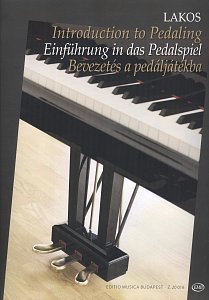Introduction to Pedaling for Pianists
| Wydawnictwo: | EDITIO MUSICA BUDAPEST |
| styl muzyczny: | muzyka klasyczna i liturgiczna |
| aranżacja : | fortepian |
| obsada: | solo |
| Stopie: | średnio zaawansowany |
| format: | książka |
Dane
| Kod produktu: | Z20016 |
| autor: | Lakos, Ágnes |
| ilość utworów: | 62 |
| ilość stron: | 79 |
| język : |
angielski
niemiecki węgierski |
| rozmiar: | 23 x 31 cm |
| ISMN: | 9790080200162 |
| waga: | 328 g |
pokaz audio
Spis utworów (62)
- Evening Bells /Lakos: A barátságos zongoraiskola III/ (Orbán György)
- Pedal Throughout Lakos / A barátságos zongoraiskola III/ (Orbán György)
- With Pedal /Lakos: A barátságos zongoraiskola III/ (Orbán György)
- Lullaby /Lasten maailmasta, Op. 31, No. 2/ (Merikanto, Oskar)
- Humming Song /Album für die Jugend, Op. 68, No. 3/ (Schumann, Robert)
- Prelude 11 /Twenty Pedal Preludes, No. 11/ (Maykapar, S. M.)
- Solfeggio /Musicalische Nebenstunden, 1787-88/ (Bach, Johann Christoph Friedrich)
- Andantino /4 Sonatinen, Op. 214, No. 2/II/ (Gurlitt, Cornelius)
- Prelude 5 /Twenty Pedal Preludes, No. 5/ (Maykapar, S. M.)
- By th Limpid Stream ú25 Etüden, Op. 100, No. 7/ (Burgmüller, J. Fr.)
- Njanja is Ill /Children's Book, Op. 98, No. 7/ (Gretchaninov, Alexander)
- The Sick Doll /Children's Album, Op. 39, No. 6/ (Tchaikovsky, Pyotr Ilyich)
- Sweet Dream úChildren's Album, Op. 39, No. 21/ (Tchaikovsky, Pyotr Ilyich)
- Study ú100 Übungsstücke, Op. 139, No. 44/ (Czerny, Carl)
- A Chorale /Album für die Jugend, Op. 68, No. 4/ )Schumann, Robert)
- Prelude 17 /Twenty Pedal Preludes, No. 17/ (Maykapar, S. M.)
- Don't be Grumpy! /Lakos: A barátságos zongoraiskola III/ (Orbán György)
- Prelude /Introduction a l'Art de toucher le Piano-Forte, 1802, Op. 42, Leçon XV/ (Clementi, Muzio)
- Tower Bells /for left hand/ - /Hungarian Folk Song , Bartók-Reschofsky: Zongoraiskola, 1913/ (Reschofsky Sándor)
- Study (Gurlitt, Cornelius)
- Prelude 1 /Twenty Pedal Preludes, No. 1/ (Maykapar, S. M.)
- Menuett /BWV Anh. II 132/ (Bach, Johann Sebastian)
- Menuett (Kirnberger, J. Ph.)
- Ländler /in Es, D. 679, No.2/ (Schubert, Franz)
- Short Study /Album für die Jugen, Op. 68, No. 14/ (Schumann, Robert)
- Highway Robber /Gyermekeknek, IV/31/ (Bartók Béla)
- Oh, my Johnny /Polish Folk Song/ /''Ach, mój Jasienko'', Melodie ludowe, No. 1/ (Lutosławski, Witold)
- Prelude 6 /Twenty Pedal Preludes, No. 6/ (Maykapar, S. M.)
- Prelude 12 /Twenty Pedal Preludes, No. 12/ (Maykapar, S. M.)
- Menuett /12 Menuette, Hob. IX:3, No. 5/ (Haydn, Joseph)
- Menuett /KV 315a /315g/ (Mozart, Wolfgang Amadeus)
- Merriment /Mikrokosmos, III/84/ (Bartók Béla)
- Tyrolean Waltz /from Villageoises/ (Poulenc, Francis)
- Melody with Interruptions /Mikrokosmos, III/83/ (Bartók Béla)
- Reeds in Winter (Orbán György)
- Prelude /32 Präludien für Lili, Op. 119, No. 9/ (Heller, Stephen)
- Entrance (Pleyel, Ignaz Josef)
- Elegy /5 Serenaden für die Jugend, Op. 183/II, No. 2/ (Reinecke, Carl)
- Prelude 4 /Twenty Pedal Preludes, No. 4/ (Maykapar, S. M.)
- First Loss /Album für die Jugend, Op. 68, No. 16/ (Schumann, Robert)
- Children's Dance /Gyermekeknek, I/10/ (Bartók Béla)
- Hungarian Folk Song /Gyermekeknek, II/26/ (Bartók Béla)
- German Dance /12 deutsche Tänze, WoO 13, No. 9/ (Beethoven, Ludwig van)
- Sonatina (Benda, Georg Anton)
- Valsette /10 Pensées lyriques, Op. 40, No. 1/ (Sibelius, Jean)
- March of a Military Band (Orbán György)
- Study /100 Übungsstücke, Op. 129, No. 63/ (Czerny, Carl)
- Children and Cuckoo /Ein neues Notenbuch für kleine Leute, Op. 107, No. 12/ (Reinecke, Carl)
- Study (Maykapar, S. M.)
- Prelude 18 /Twenty Pedal Preludes, No. 18/ (Maykapar, S. M.)
- Little Study (Orbán György)
- Flowing Brook /Lakos: A barátságos zongoraiskola II./ (Orbán György)
- Swelling /Lakos: A barátságos zongoraiskola II./ (Orbán György)
- Under the Linden (Schytte, Ludvig)
- Clouds, Flashing Light, and Raibow (Orbán György)
- Cradle Song /Albumblätter für die Jugend, Op. 101, No. 6/ (Gurlitt, Cornelius)
- Prelude 19 /Twenty Pedal Preludes, No. 19/ (Maykapar, S. M.)
- Prelude 20 /Twenty Pedal Preludes, No. 20/ (Maykapar, S. M.)
- In the Chuch /Children's Album, Op. 39, No. 24/ (Tchaikovsky, Pyotr Ilyich)
- A Teardrop (Mussorgsky, Modest Petrovich)
- Like a Folk Song (Orbán György)
- Adventure of a Motiv (Orbán György)
Opis produktu
Pedal use is a fundamental part of expressive piano playing. But proper pedaling skills are not easy to acquire. Thus, it is important that piano students become acquainted with the use of the three pedals as early as possible. The stopgap Introduction to Pedaling is a collectionof pieces adapted to all levels of manual dexterity, enabling learners to improve their mastery of both the musical function and technique of pedaling. The volume contains both individual and joint studies for the three pedals of modern pianos.
In addition to ten selected pieces from Samuel Maykapar's Twenty Pedal Preludes (1937), Introduction to Pedal Studies includes keyboard music from four centuries, ranging from Johann Sebastian Bach to contemporary Hungarian composers. Pupils can thus encounter varying pedal marks from different periods. Of course, not all composers featured in the collection marked pedal use; in such cases, pedal signs were added by the editor. It is a recurrent question of interpretation whether pedals should be used in the music of earlier masters. The sound of the modern piano is far less vibrant and rich in overtones than that of the period instruments - thus, it is not Bach's music that necessitates pedal use so much as the piano itself.









